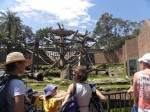Roles and responsibilities of zoos
The following will give us plenty to think about and discuss in the lead-up to the national wildlife tourism workshop. Larry will be leading a discussion group on this topic during the workshop.
The Repositioning of Zoos as Conservation Organisations Evaluating the Perceptions of Stakeholders
National Wildlife Tourism Workshop May 2012
Larry Perry
Australia’s Biodiversity Conservation Strategy 2010-2030 identifies amongst its priorities the engagement of all Australians in biodiversity conservation, the building of ecosystem resilience in a changing climate and the attainment of measurable results (Natural Resource Management Ministerial Council 2010 2010). The strategy identifies 10 national targets to be met by 2015, the first and of most relevance to zoos, being that ‘by 2015, [Australia] achieves a 25% increase in the number of Australians and public and private organisations who participate in biodiversity conservation activities’. The World Zoo Conservation Strategy (Olney 2005) has identified similar aspirations and many zoos worldwide have made significant efforts to transform their organisations from places of leisure and recreation to include a major role for them as conservation centres. This transformation is progressing and zoos around the world are at different stages of this endeavour.
Zoos have, particularly over the last 10 to 15 years, been strategically promoting and acting upon issues of environmental and biodiversity conservation and changing their marketing and operational approaches as a means to fulfilling, marketing and promoting their missions and objectives as conservation organisations (Mazur and Clark 2001; Tribe and Booth 2003; Hancocks 2007; Evans 2008; Dickie 2009; Fraser and Sickler 2009; Lees and Wilcken 2009; Gusset and Dick 2010).
Understanding how zoos are progressing in this transformation is a new dilemma for zoos and, despite years of debate and discussion amongst zoo professionals over the role and success of zoos as conservation organisations, there is little academic research that offers rich insights into their successes and their transformations. Much of the debate and research in the zoo literature relates to the evaluation of species specific programs and the value of zoos in engaging zoo visitors during a zoo visit, zoo visitor satisfaction and associated marketing research along with some research on the value of interpretive educational activities. A new approach may provide the understanding.
References
Dickie, L. A. (2009). “The sustainable zoo: an introduction.” International Zoo Yearbook 43(1): 1-5.
Evans, K. (2008). Conservation Ark: an integrated approach to science and conservation at Zoos South Australia. 2009 ARAZPA Conference. Gold Coast Australia, ARAZPA.
Fraser, J. and J. Sickler (2009). “Measuring the cultural impact of zoos and aquariums.” International Zoo Yearbook 43(1): 103-112.
Gusset, M. and G. Dick (2010). “‘Building a Future for Wildlife’? Evaluating the contribution of the world zoo and aquarium community toin situconservation.” International Zoo Yearbook 44(1): 183-191.
Hancocks, D. (2007). The Future And Ethics of Zoos.
Lees, C. M. and J. Wilcken (2009). “Sustaining the Ark: the challenges faced by zoos in maintaining viable populations.” International Zoo Yearbook 43(1): 6-18.
Mazur, N. and T. Clark (2001). “Zoos and Conservation: Policy making and organisational challenges.” Species and Ecosystem Conservation: An Interdisciplinary Approach Yale F & E S Bulletin Bulletin 105: 185-201.
Natural Resource Management Ministerial Council 2010 (2010). Australia’s Biodiversity Conservation Strategy 2010-2030. Canberra, Australian Government,.
Olney, P. (2005). Building a future for wildlife The world Zoo and Aquarium Conservation Strategy. Bern Switzerland, WAZA.
Tribe, A. and R. Booth (2003). “Assessing the Role of Zoos in Wildlife Conservation.” Human Dimensions of Wildlife 8(1): 65-74.

